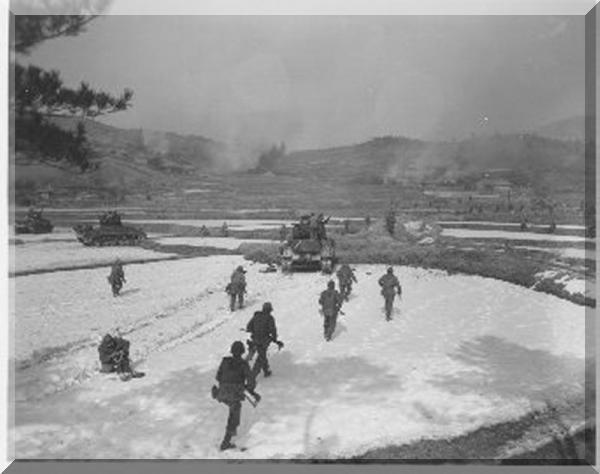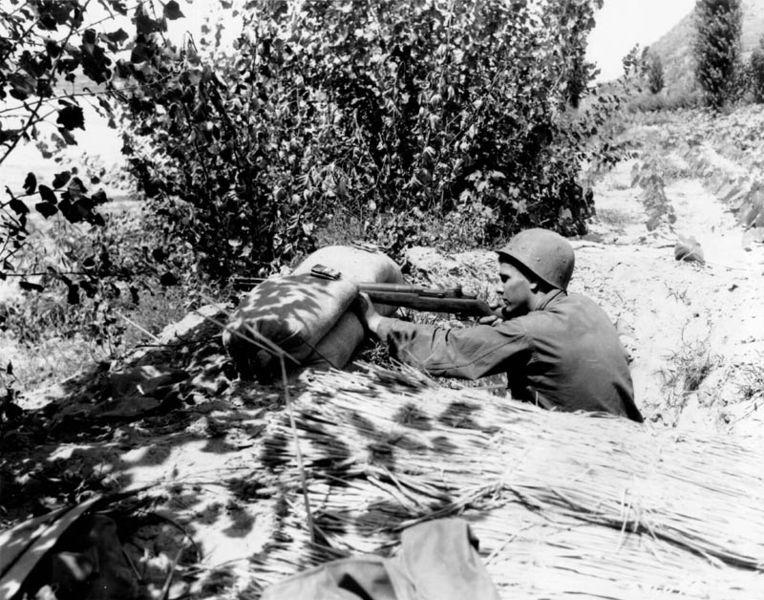-
FREE MEMBER
NO Posting or PM's Allowed

12-260 Garand Picture of the day
Men of 3rd Bn, 8th Cav Regt and tanks from 10th Tank Co, 24th Inf Div assault hill North of Wangok,Korea.

Information
 |
Warning: This is a relatively older thread
This discussion is older than 360 days. Some information contained in it may no longer be current. |
|
-
09-19-2012 06:29 AM
# ADS
Friends and Sponsors

-
Contributing Member


8th Cavalry Regiment

Pfc. Letcher V. Gardner (Montgomery, Iowa)Co D, 8th Cavalry, 1st Cavalry Division, fires on an emplacement along the Naktong River, near Chingu. 13 August 1950.
SC346078 - Signal Corps Photo #8A /FEC-50-6133 (Meyers)
The regiment saw vicious fighting during the Korean War, with 3 of its members earning the Medal of Honor (Samuel S. Coursen (12 December 1950), Robert M. McGovern (30 January 1951), and Lloyd L. Burke (28 October), 1951)).
Initially scheduled to make an amphibious landing at Inchon, it was redirected to the southeastern coast of Korea at Pohang-dong a port 80 miles (130 km) north of Pusan on 30 June 1950. The North Koreans were 25 miles (40 km) away when elements of the 1st Cavalry Division swept ashore to successfully carry out the first amphibious landing of the Korean War. The 8th Cavalry Regiment, reinforced by division artillery and other units, moved by rail, truck and jeep to relieve the 21st Regiment, 24th Division near Yongdong. By 22 July, all regiments were deployed in battle positions; in itself a remarkable logistical achievement in the face of Typhoon Helene that pounded the Korean coastline.
Thousands of Communist Chinese Forces attacked from the north, northwest, and west against scattered U.S. and South Korean (Republic of Korea or ROK) units moving deep into North Korea. At 1930 on 1 November 1950 the Chinese attacked the 1st Battalion, 8th Cavalry, all along its line. At 2100 CCF troops found the weak link in the ridgeline and began moving through it and down the ridge behind the 2d Battalion, penetrating its right flank and encircling its left. Now both the 1st and 2d Battalions were engaged by the enemy on several sides. Around midnight the 8th Cavalry received orders to withdraw southward to Ipsok.
As of 0130 on 2 November there were no reports of enemy activity in the 3d Battalion’s sector south of Unsan. But as the 8th Cavalry withdrew, all three battalions became trapped by CCF roadblocks south of Unsan during the early morning hours. Within hours the ROK 15th Regiment on the 8th Cavalry’s right flank collapsed, while the 1st and 2d Battalions of the 8th Cavalry fell back in disarray into the city of Unsan. By morning, with their positions being overrun and their guns falling silent, the men of the 8th Cavalry tried to withdraw, but a Chinese roadblock to their rear forced them to abandon their artillery, and the men took to the hills in small groups. Only a few scattered survivors made it back to tell their story. Members of the 1st Battalion who were able to escape reached the Ipsok area. A head count showed that the battalion had lost about 15 officers and 250 enlisted men. Members of the 2d Battalion, for the most part, scattered into the hills. Many of them reached the ROK lines near Ipsok. Others met up with the 3d Battalion, the hardest hit. Around 0300 the Chinese launched a surprise attack on the battalion command post. Hand-to-hand fighting ensued for about half an hour before the enemy was driven from the area. The disorganized members of the 3d Battalion formed a core of resistance around three tanks on the valley floor and held off the enemy until daylight. By that time only 6 officers and 200 enlisted men were still able to function. More than 170 were wounded, and there was no account of the number dead or missing.[10]
The remaining battalion of the 8th Cavalry, the 3d, was hit early in the morning of 2 November with the same "human wave" assaults of bugle-blowing Chinese. In the confusion, one company-size Chinese element was mistaken for South Koreans and allowed to pass a critical bridge near the battalion command post (CP). Once over the bridge, the enemy commander blew his bugle, and the Chinese, throwing satchel charges and grenades, overran the CP.
Elements of the two other regiments of the 1st Cavalry Division, the 5th Cavalry Regiment and 7th Cavalry Regiment, tried unsuccessfully to reach the isolated battalion. The 5th Cavalry, commanded by then Lt. Col. Harold K. Johnson, later to be Chief of Staff of the Army, led a two-battalion counterattack on the dug-in Chinese positions encircling the 8th Cavalry. However, with insufficient artillery support and a determined enemy, he and his men were unable to break the Chinese line. With daylight fading, the relief effort was broken off and the men of the 8th Cavalry were ordered to get out of the trap any way they could. Breaking into small elements, the soldiers moved out overland under cover of darkness. Most did not make it. The bitter fighting which had raged over five days saw many heroes and many memorable sacrifices, but it also stands for the most painful chapter in the proud history of the 1st Cavalry Division. On 6 November, the 3rd Battalion, 8th Cavalry Regiment ceased to exist as a unit, but died gallantly.[11] In all, over eight hundred men of the 8th Cavalry were lost—almost one-third of the regiment’s strength—in the initial attacks by massive Chinese forces, forces that only recently had been considered as existing only in rumor.[12]
The enemy force that brought tragedy to the 8th Cavalry at Unsan was the CCF’s 116th Division. Elements of the 116th’s 347th Regiment were responsible for the roadblock south of Unsan. Also engaged in the Unsan action was the CCF’s 115th Division.
On 25 January 1951, the First Cavalry Division, joined by the revitalized 3rd Battalion, 8th Cavalry rebounding from its tragedy at Unsan, moved back into action. The movement began as a reconnaissance in force to locate and assess the size of the Chinese Army, believed to be at least 174,000. The Eighth Army moved slowly and methodically, ridge by ridge, phase line by phase line, wiping out each pocket of resistance before moving farther North. The advance covered 2 miles (3.2 km) a day, despite heavy blinding snowstorms and subzero temperatures. On 14 March, the 3rd Battalion, 8th Cavalry had crossed the Hangchon River and on the 15th, Seoul was recaptured by elements of the 8th Army. New objectives were established to keep the Chinese from rebuilding and resupplying their forces and to advance to the "Kansas Line", which roughly followed the 38th Parallel and the winding Imjin River. On 3 October, the 1st Cavalry Division moved out from Line Wyoming and immediately into Chinese fire. For the next two days; hills were taken, lost and retaken. On the third day, the Chinese lines began to break in front of the 7th Cavalry. On 5 October, the 8th Cavalry recaptured Hill 418, a flanking hill on which the northern end of Line Jamestown was anchored. On 10–11 October, the Chinese counter-attacked; twice, unsuccessfully against the 7th Cavalry. Two days later, the 8th Cavalry took the central pivot of the line, Hill 272. The southern end of Line Jamestown, along with a hill called "Old Baldy", eventually fell to the determined 8th Cavalry troopers.
By December 1951, the division, after 549 days of continuous fighting, began rotation back to Hokkaidō, Japan . The final echelon of the 1st Cavalry Division, the 8th Cavalry Regiment, left for Japan on 30 December. The First Team had performed tough duties with honor, pride and valor with distinction.
. The final echelon of the 1st Cavalry Division, the 8th Cavalry Regiment, left for Japan on 30 December. The First Team had performed tough duties with honor, pride and valor with distinction.
After the Korean War the 8th Cavalry remained in the Far East on duty in Japan and guarding the Demilitarized Zone (DMZ) between North and South Korea.
Last edited by Mark in Rochester; 09-19-2012 at 06:11 PM.
He is no fool who gives what he cannot keep to gain that which he cannot lose
There are no great men, only great challenges that ordinary men are forced by circumstances to meet.
-
The Following 6 Members Say Thank You to Mark in Rochester For This Useful Post:
-
FREE MEMBER
NO Posting or PM's Allowed

-
Contributing Member


Sorry - had my ESP off:-)
found info that Letcher V. Gardner is still with us
He is no fool who gives what he cannot keep to gain that which he cannot lose
There are no great men, only great challenges that ordinary men are forced by circumstances to meet.
-
 Information
Information














 Register To Reply
Register To Reply










